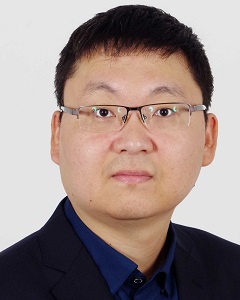
职称:副研究员
邮箱:bailong@hust.edu.cn
个人基本情况
白龙(Bai Long,Associate Researcher),华中科技大学机械学院副研究员,博士生导师,湖北省高层次人才。2010年、2013年先后于北京大学元培学院、北京大学工学院获得学士学位与硕士学位,2018年1月毕业于英国布里斯托大学机械工程系,获博士学位。2018年至2020年在英国布里斯托大学超声无损检测实验室从事博士后研究工作,于2020年5月进入华中科技大学。
主要研究方向为超声无损检测、智能制造、智能机器人等,在IEEE Trans. Ultrason. Ferroelectr. Freq. Control,NDT E Int.,J. Acoust. Soc. Am.等期刊上发表论文10余篇。主持国家重点研发计划课题、国家自然科学基金青年基金项目、湖北省重点研发计划项目各一项。
主要研究方向
超声无损检测
智能制造
智能机器人
开设课程
本科生课程:机械设计理论与方法(二),传感技术与信号电路
研究生课程:学术规范与论文写作
近年的科研项目、专著与论文、专利、获奖
科研项目
[1] 国家重点研发计划课题,“工业机器人离线编程与免示教部署技术研究”,462.5万,2022—2024(负责人)
[2] 国家自然科学基金青年项目,“基于超声散射矩阵的小缺陷表征技术”,24万,2021—2023(负责人)
[3] 湖北省重点研发计划项目,“面向航天核心部件亚表层损伤的新型相控阵检测技术与系统研究”,100万,2023—2025(负责人)
[4] 欧盟地平线2020计划项目,“Advanced Inspection of Complex Structures”,2017—2020(参与人)
[5] 英国EPSRC项目,“UK Research Council in Non-Destructive Evaluation”,2014—2017(参与人)
论文与专著
代表性著作:
[1] L. Bai, Q. Yang, X. Cheng, Y. Ding, J. Xu*. A hybrid physics-data-driven surface roughness prediction model for ultra-precision machining. Science China Technological Sciences 2023, in press.
[2] L. Bai, X. Cheng, Q. Yang, J. Xu*. Predictive model of surface roughness in milling of 7075Al based on chatter stability analysis and back propagation neural network. The International Journal of Advanced Manufacturing Technology 2023, 126: 1347-1361.
[3] C. Guo, J. Ren, J. Xu, L. Bai*. Ultrasonic defect characterization using Bayesian inversion and scattering matrix denoising neural networks. NDT&E International 2023, 136:102813.
[4] L. Bai, F. Xu, X. Chen, X. Su, F. Lai, J. Xu*. A hybrid deep learning model for robust prediction of the dimensional accuracy in precision milling of thin-walled structural components. Frontiers of Mechanical Engineering 2022, 17(3):32.
[5] L. Bai, N. Liu, C. Guo, J. Xu*. Ultrasonic defect characterization using time-domain scattering matrices and convolutional sparse coding. NDT&E International 2022, 131:102699.
[6] L. Bai, M. Liu, N. Liu, X. Su, F. Lai, J. Xu*. Dimensionality reduction of ultrasonic array data for characterization of inclined defects based on supervised locality preserving projection. Ultrasonics 2022, 119:106625.
[7] L. Bai*, J. Zhang, A. Velichko, B. W. Drinkwater. The use of full-skip ultrasonic data and Bayesian inference for improved characterisation of crack-like defects. NDT&E International 2021, 121:102467.
[8] L. Bai*, F. Le Bourdais, R. Miorelli, P. Calmon, A. Velichko, B. W. Drinkwater. Ultrasonic defect characterization using the scattering matrix: A performance comparison study of Bayesian inversion and machine learning schemas. IEEE Transactions on Ultrasonics, Ferroelectrics, and Frequency Control 2021, 68(10): 3143-3155.
[9] L. Bai*, A. Velichko, A. T. Clare, P. Dryburgh, D. Pieris, B. W. Drinkwater. The effect of distortion models on characterisation of real defects using ultrasonic arrays. NDT&E International 2020, 113:102263.
[10] L. Bai*, A. Velichko, B. W. Drinkwater. Grain scattering noise modeling and its use in the detection and characterization of defects using ultrasonic arrays. IEEE Transactions on Ultrasonics, Ferroelectrics, and Frequency Control 2019, 66(11): 1798-1813.
[11] L. Bai*, A. Velichko, B. W. Drinkwater. Ultrasonic defect characterisation-Use of amplitude, phase, and frequency information. Journal of the Acoustical Society of America 2018, 143(1):349-360.
[12] L. Bai*, A. Velichko, B. W. Drinkwater. Characterization of defects using ultrasonic arrays: A dynamic classifier approach. IEEE Transactions on Ultrasonics, Ferroelectrics, and Frequency Control 2015, 62(12): 2146-2160.
[13] L. Bai*, A. Velichko, B. W. Drinkwater. Ultrasonic characterization of crack-like defects using scattering matrix similarity metrics. IEEE Transactions on Ultrasonics, Ferroelectrics, and Frequency Control 2015, 62(3): 545-559.
[14] L. Bai, X. Huang*. Observer-based beamforming algorithm for acoustic array signal processing. Journal of the Acoustical Society of America 2011, 130(6):3803-3811.
荣誉与奖励
[1] University of Bristol Postgraduate Research Scholarship (2013年-2017年)
[2] 北京市优秀毕业生 (2013年)
[3] 硕士研究生国家奖学金 (2012年)